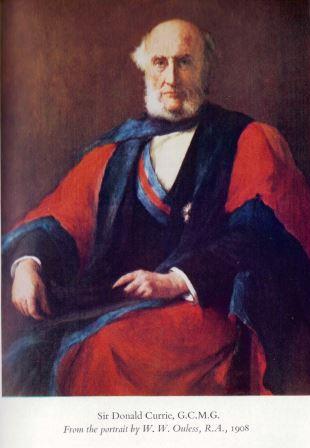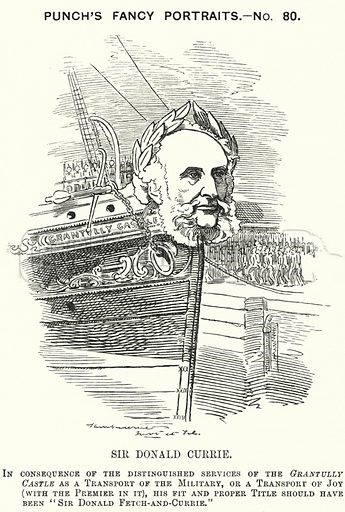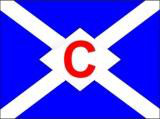In 1893 Sir Donald is recorded as having given a cheque to the Poor Jews Temporary Shelter in London. This was one of many cheques received from both the Castle and Union Lines. The Shelter served as a temporary residence for many Jews who made their way to South Africa as immigrants in the late 1800s and early 1900s. Sir Donald also made a donation in 1906 when the Shelter moved into a new building.
In 1893 the Union Steamship Company opened its own hotel in Cape Town, The Grand in Strand Street (demolished in 1973). Six years later, on the 6th March 1899, Sir Donald’s Castle Steamship Company opened a first class hotel on the Mount Nelson estate in Gardens. It was designed by English architects and managed at first by a Swiss, Emil CATHREIN. The Mount Nelson attracted an exclusive clientele. During the Anglo-Boer War it was the unofficial headquarters of the British Army and was often referred to as “Helots’ Rest”. Today it is more commonly known as Nellie or the Pink Lady, due to its famous” Mount Nelson ‘s Blush” paint which was first mixed for the hotel in the 1920s. The hotel has an interesting collection of memorabilia from the days of the Union-Castle Line.
The present-day Centre for the Book is the finest Edwardian building in Cape Town. It was built just before WWI for the University of the Cape of Good Hope, on land donated by Willem HIDDINGH who also gave money, along with money from Sir Donald Currie. Both men are commemorated by bas-relief portrait busts in the entrance hall. The building was sold to the State in 1932 and became the Cape Archives Depot until they moved out in February 1990. The building was proclaimed a National Monument in 1990.
In 1908 his health began to fail. He died at Manor House, Sidmouth, Devon on the 13th April 1909 and was buried at Fortingall, Perthshire. A sculptured cross of granite, ten feet in height, marks his grave. A marble bust of Sir Donald is at Dunkeld Cathedral in Scotland. He paid for the cathedral’s restoration work in 1908, in gratitude to the minister’s daughter, who had nursed him through a serious illness.
He was married to Margaret MILLER, daughter of J. MILLER of Ardencraig. They had three daughters. A year after his death, his daughters donated £25,000 to the University of the Cape of Good Hope. A bronze plaque, with a relief profile, was placed in the entrance hall of the former building of the University to commemorate this gift.
Sir Donald acquired estates in Scotland and collected Turner paintings. Churches, universities and the city of Belfast benefited from his generous spirit. In 1880 he was awarded the Fothergill gold medal by the Royal Society of Arts.

Sir Donald CURRIE was born in Greenock, Scotland on the 17th September 1825. He was the third son in a family of ten children born to James CURRIE (1797 – 1851), a barber, and Elizabeth MARTIN (1798 – 1839). He had four sisters and five brothers.
Donald was an infant when his parents moved to Belfast. There he attended Belfast Royal Academy, the oldest school in Belfast and where one of the Houses was later named after him.
At the age of 14, Donald started working at uncle’s sugar refining business – Hoyle, Martin & Co. in Greenock. This was not what he wanted and looking at his brother James, who worked as an engineer, he left and in 1844 joined the Cunard Steamship Company as a clerk.
His career progressed so well that from 1849 to 1854 he established the company’s offices in Le Havre, Paris, Bremen and Antwerp. In 1854 he returned to its Liverpool head office. In 1862 he resigned and started his own North Sea shipping enterprise.
He also founded the Castle Shipping Line which operated between Liverpool and Calcutta. By 1863 he had four new ships: the Stirling Castle, Roslin Castle, Warwick Castle and the Pembroke Castle. The next year two more ships joined the fleet: the Kenilworth Castle and the Arundel Castle. The Tantallon Castle joined the fleet in 1865 and was followed by the Carnarvon Castle (1867), Carisbrooke (1868) and the first steamship, the Dover Castle (1872).
In 1864 he made London the capital port for his ships. The London ship repair yards of the Castle Shipping Line, under the trading name of Donald Currie & Co., were founded on the banks of the River Lea. Later he switched from sail to steam and entered the Cape trade with sailings from Dartmouth, the first vessel to enter the service being the Iceland which departed on the 23rd January 1872.
His enterprise proved popular and soon the Union Steamship Company, which had enjoyed a monopoly, lost a large share of its traffic to the new line. He introduced fixed schedules, regardless of how little cargo was booked. Donald’s ships were in competition with the ships that had the Royal Mail run, as those ships were given precedence at ports.
The first ship that Donald owned (instead of chartered) to do the Cape run was the Walmer Castle. It departed from Dartmouth and called at Bordeaux before arriving at the Cape in October 1872. In May 1873 the Windsor Castle reduced the passage time to the Cape to 23 days.
In 1876 the Cape mail contract was divided between the two lines and keen competition led to quicker voyages. Donald created the Castle Mail Packet Company with offices located at the Castle Shipping Line headquarters. Anderson & Murison were the Cape Town agents for Castle Mail Packet Co. with James MURISON being given Power of Attorney for all its business. He was assisted by Thomas Ekins FULLER, who later became Sir Thomas FULLER, High Commissioner for the Cape Colony, in London. Captain James lived in Sea Point for many years and was Cape Town ‘s most famous nautical man referred to as “the figurehead of Table Mountain, a prince among men” and “public-spirited, incorruptible and generous to a degree”. He first saw Table Bay in 1838, when he arrived from Scotland as mate aboard the Sir William Heathcote, a small brig that later traded along the coast, between Cape Town and Knysna. He later became a partner in the shipping firm of Anderson & Murison. He died at home in Sea Point in 1885.
Donald became quite involved in South African issues. On the 10th April 1875, President Thomas Francois BURGERS left Cape Town on the Walmer Castle on his way to England. The Transvaal Vierkleur was hoisted on that voyage when BURGERS celebrated his birthday. He met Donald at Plymouth and was hosted by him in London, where Donald assisted with the negotiations on the building of a railway to Delagoa Bay. In 1876 President Johannes (Jan) Hendrikus BRAND of the Orange Free State was also hosted by Donald. Donald helped to negotiate the diamond-fields compensation, receiving the C.M.G. and being thanked by the Orange Free State Volksraad. In 1877 and 1878 the Transvaal delegates of the first and second deputation which went to London to protest against the British annexation of the Transvaal turned to Donald for introductions to the Colonial Office. Stephanus Johannes Paulus KRUGER first met William Ewart GLADSTONE on one of Donald’s steamers during a Thames trip to Gravesend. Donald was also an active supporter of the return of the Transvaal to the Boers.
A model of the Dunvegan Castle was presented to President KRUGER by Sir Donald Currie. The model was first exhibited at the entrance of the State Museum of the South African Republic. It is now housed at Kruger House Museum in Pretoria.
The first news of the 1879 Battle of Isandlwana in the Zulu War was given to the London government through Donald’s shipping line. At that time there was no cable between England and South Africa. The news was sent by a Castle liner to St Vincent, and telegraphed from there to Donald. By diverting the outward mail ships, he helped the British government to telegraph faster instructions to St Vincent for conveyance by mail. This saving of time helped prevent the annihilation of the British garrison at Eshowe.
In 1881 Donald received the K.C.M.G. He was now a shipping magnate and a recognized authority on merchant shipping legislation, being responsible for important amendments to the Merchant Shipping Act of 1876.
He was a close friend of GLADSTONE. After an unsuccessful attempt at Greenock in 1878, in 1880 he entered Parliament as a Liberal member for Perthshire. In 1885 his political allegiance changed over the Irish question and, until his retirement from active politics in 1900, he was a Liberal Unionist supporting Joseph CHAMBERLAIN. He backed the British annexation of Damaraland, where he had business interests, forming a company to exploit the Otavi copper mine and St Lucia bay, which was annexed at the end of 1885.

As a Member of Parliament, he came up with the idea of converting fast merchant ships into armed merchant cruisers. This eventually led to the use of merchant ships in time of war. The Kinfauns Castle, built in 1879, was done so with this in mind.
In 1886-87, he made his first tour of South Africa. His business interests by then included diamonds and gold, and in 1888 he was one of the original directors of De Beers Consolidated Mines Ltd.
In 1891 the Dunottar Castle brought a British rugby team on a tour of South Africa. Sir Donald had given them a golden trophy to be used for internal competition. At the end of the tour the British team presented the cup to Griqualand West, the province they believed had produced the best performance of the tour. Sir Donald also donated a trophy for cricket competitions.
When the second Anglo-Boer War broke out, his fast steamers were in high demand. In 1900 the Dunottar Castle carried General BULLER and 1,500 British soldiers to the Anglo-Boer War. Sir Donald did not share the pro-Boer views of his son-in-law, Percy Alport MOLTENO (married to Elizabeth), on the causes of hostilities. Percy had joined his father-in-law’s business and on Sir Donald’s death in 1909, he inherited a large proportion of the estate.
It was Percy who started South Africa ‘s fruit exports to England, when in February 1892, the first 14 crates of peaches from the Stellenbosch district arrived at Covent Gardens. As manager Castle Mail Packets, Percy ensured that the ships had cold storage facilities. The first peaches, bearing the label “Cape Peaches”, were transported aboard the Drummond Castle which departed from Cape Town on the 13th January 1892.
When the Cape mail contract came up for renewal in late 1899, it was decided to award the contract to one shipping line. Instead of the Castle Shipping Line and the Union Line bidding for it on their own, Sir Donald proposed a merger of the two lines. On the 8th March 1900, the Union-Castle Mail Steamship Company Ltd. was registered. The reception to celebrate the merger was held aboard the Dunottar Castle.
During a visit to Cape Town, Sir Donald saw the Cape Town Highlanders parading in full uniform. He was so impressed that he asked to meet the Officer Commanding. He acquired a Highland stag to lead the regiment. The stag, named Donald, was stabled at regiment’s headquarters in Buitenkant Street and looked after by a keeper, Private McDONALD. Sir Donald was made a life member of the regiment and on his departure a Guard of Honour was formed as he boarded the ship back to England.

He received the G.C.M.G. in 1897. In 1906 the University of Edinburgh conferred an honorary LL.D. degree on him, and he was granted the freedom of the city of Belfast. He endowed at his old school, Belfast Royal Academy, the school’s most prestigious scholarship known as the Sir Donald Currie Scholarship.
For many years, it was Sir Donald’s ships that brought mail, cargo, immigrants and visitors to South Africa. Many South Africans have fond memories of sailing on his ships or watching them while in port. Shipping advertisements in England and South Africa stated that they provided cheap steerage and third class passenger fares.
The other shipping companies that specialised in passengers and cargo to Cape Town or dropped off passengers in Cape Town while their ships were en route to New Zealand or Australia could not offer cheaper rates. Between 1891 and 1900 the Union Line had 12 new ships, each capable of carrying about 800 third class passengers and about 400 in steerage. The Castle Line, at the same time, had 24 new ships, many of them capable of carrying between 100 and 150 third class passengers with several hundred in steerage.
In the late 1880s the Board of Trade reported that there were over 16,000 passengers travelling to African ports.
Sir Donald Currie
KCMG




